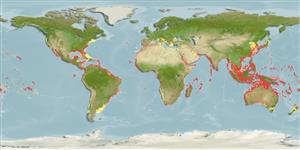Common names from other countries
>
Carangiformes (Jacks) >
Echeneidae (Remoras)
Etymology: Echeneis: Greek, echein = to hold + Greek, nays = ship; remora, suckling fish; 1774 (Ref. 45335).
More on author: Linnaeus.
Environment: milieu / climate zone / تغييرات عمق / distribution range
بوم شناسي
دريايي; لب شور وابسته به آب سنگ; تغييرات عمق 1 - 85 m (Ref. 86942). Subtropical; 45°N - 45°S, 180°W - 180°E
Circumtropical.
Size / Weight / سن
بلوغ: Lm ? range ? - ? cm
Max length : 110 cm TL جنس نر / بدون خواص جنسي; (Ref. 9710); common length : 66.0 cm SL جنس نر / بدون خواص جنسي; (Ref. 10970); بيشينه وزن گزارش شده: 2.3 kg (Ref. 40637)
خارهاي باله پشتي (کل) : 0; شعاع نرم باله پشتي (کل) : 32 - 42; خارهاي باله مخرجي: 0; شعاع نرم باله مخرجي: 29 - 41.
Body shape (shape guide): elongated.
Most abundant remora in warm waters (Ref. 4389). Occurs near as well as far from the coast (Ref. 5217). Often found free-swimming in shallow inshore areas and around coral reefs (Ref. 26938). Attaches temporarily to a variety of hosts including sharks, rays, large bony fishes or sea turtles, whales, dolphins and also to ships. May follow divers (Ref. 9710); reported to attach itself to a diver's leg (Ref. 57809). Feeds on small fishes, bits of its host's prey and host's parasites (Ref. 26938). Juveniles occasionally act as reef station-based cleaners, where they service parrotfishes (Ref. 40095). Sometimes used by natives to aid in fishing; a line is tied to the caudal peduncle of the remora and then is released; upon attaching to another fish, the remora and its host are hauled in by the fisher (Ref. 9682).
Life cycle and mating behavior
بلوغ | تولید مثل | تخم ریزی | تخم ها | Fecundity | توزاد ( لارو)
Paxton, J.R., D.F. Hoese, G.R. Allen and J.E. Hanley, 1989. Pisces. Petromyzontidae to Carangidae. Zoological Catalogue of Australia, Vol. 7. Australian Government Publishing Service, Canberra, 665 p. (Ref. 7300)
وضعيت در فهرست قرمز IUCN (Ref. 130435: Version 2025-1)
خطر برای انسان ها
Harmless
استفاده انسانی
ماهي گيري – شيلات: ارزش تحاري اندك; ماهي ها ي سرگرم كننده: بله; آكواريوم: تجاري
ابزارها
گزارش های ويژه
بارگيری XML
منابع اينترنتي
Estimates based on models
Preferred temperature (مرجع
123201): 18.3 - 28.6, mean 27.2 °C (based on 566 cells).
Phylogenetic diversity index (مرجع
82804): PD
50 = 0.7539 [Uniqueness, from 0.5 = low to 2.0 = high].
Bayesian length-weight: a=0.00257 (0.00110 - 0.00600), b=3.17 (2.96 - 3.38), in cm total length, based on LWR estimates for this (Sub)family-body shape (Ref.
93245).
Trophic level (مرجع
69278): 3.7 ±0.3 se; based on diet studies.
جهندگی (مرجع
120179): متوسط, كمينه زمان لازم براي دو برابر شدن جمعيت 4/1 – 4/4 سال (Assuming Fec < 10,000).
Fishing Vulnerability (Ref.
59153): High to very high vulnerability (66 of 100).
🛈
Nutrients (Ref.
124155): Calcium = 22.5 [10.7, 37.1] mg/100g; Iron = 0.59 [0.32, 0.99] mg/100g; Protein = 19.8 [18.7, 20.8] %; Omega3 = 0.128 [0.068, 0.250] g/100g; Selenium = 28.3 [13.0, 54.4] μg/100g; VitaminA = 25.8 [8.3, 87.1] μg/100g; Zinc = 0.702 [0.456, 1.085] mg/100g (wet weight);
